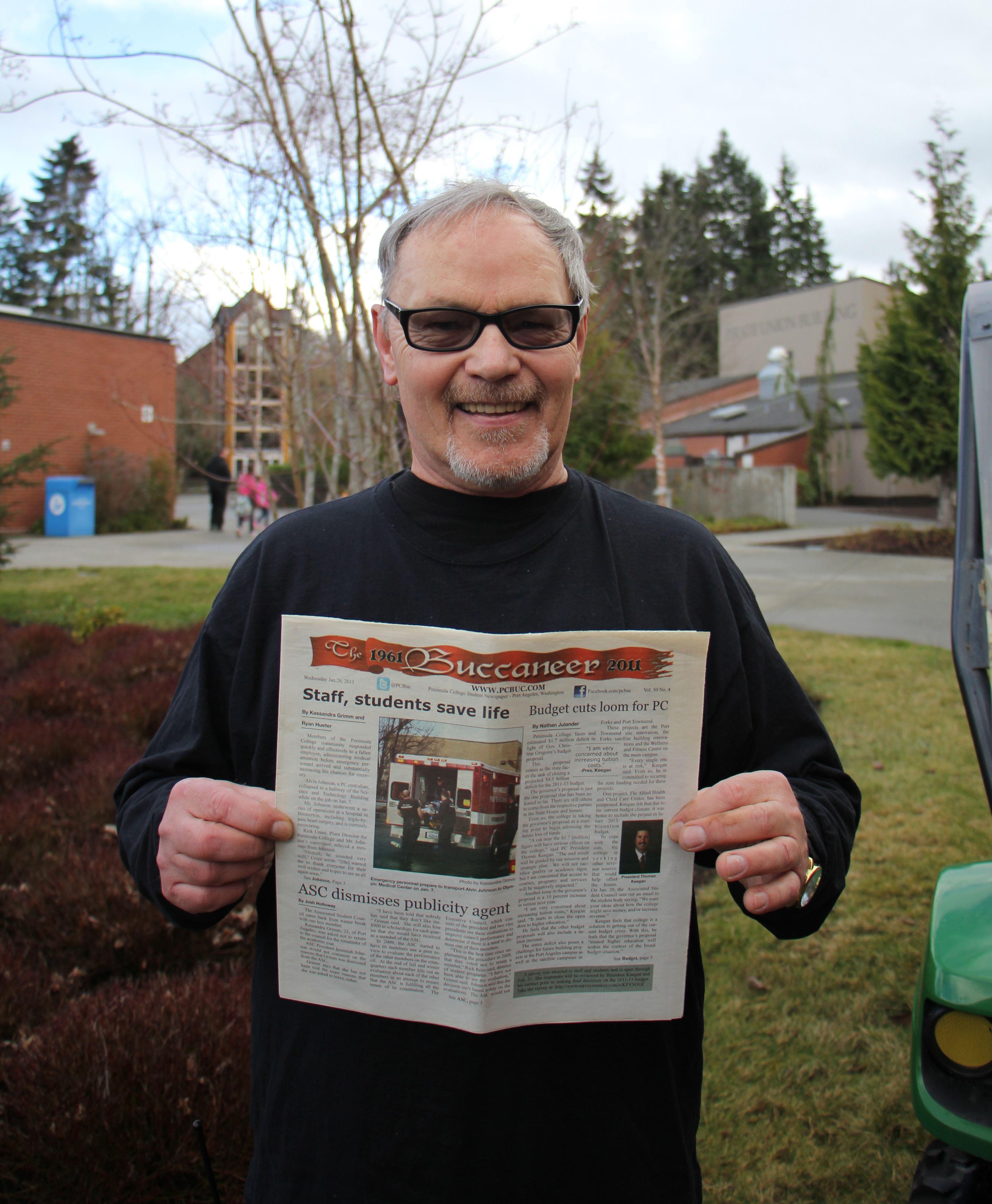
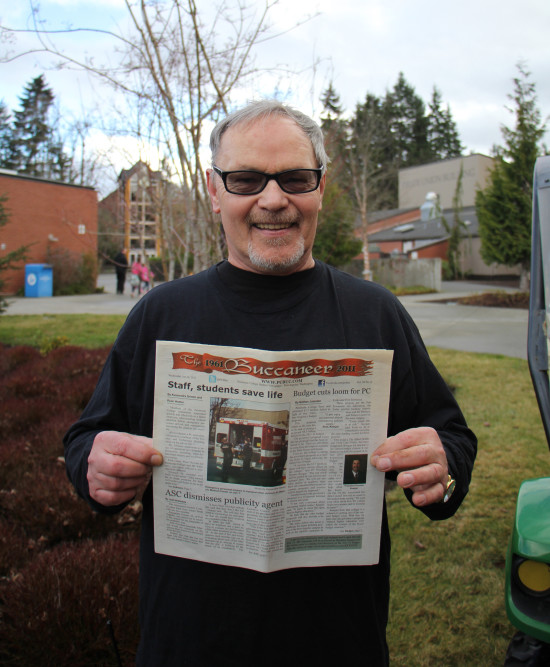
By Eric Trent
People look at the past to rekindle old memories, relive past experiences or examine the before and after effects of seminal events.
Here at The Buccaneer, we have taken a look at past Buccaneer stories and articles to provide a window into a lost era, and a time forgotten.
Many historical events here on campus have come and gone, only relevant for a short-period of time, before being whisked away by the always-pressing, ever-looming future.
Whether traversing the entire Olympic Peninsula in 14 hours on public transit, or visiting Clallam Bay Corrections Facility to get a crash course in their education process, the hope is that others can appreciate the individuals and events contained in these stories that have made a lasting impact here on campus.
After many hours of research and digging through every Buccaneer story in the last 10 years, The Buccaneer staff has compiled and voted on the top stories of the decade.
Starting from the number six story, and making way to the number one story, here are the top-six Buccaneer stories of the last decade.
6# Prison of the mind; educating the incarcerated
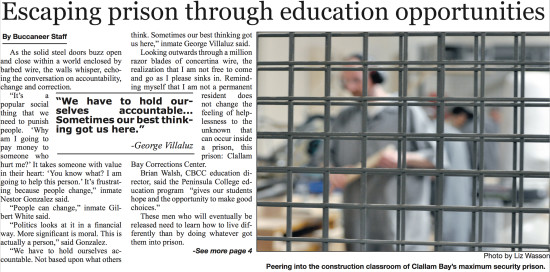
By Melissa Copeland
The education program at Clallam Bay Corrections Center CBCC has done nothing but grow in the recent years since an article written by The Buccaneer staff was published.
“The program has matured to a higher level of education,” Dayle Lee, the instructor of the bakery at CBCC, said.
He has received letters of appreciation from several fundraisers and non-profit organizations that they have made donations to.
“Personally, the goal is to raise the bar as high as possible.The more opportunities that we can give students for growth, the further they will go,” CBCC Computer Software Engineer Instructor Raymond Pulsipher said.
“Many of these guys are hungry for quality education. It is very rewarding to see the light bulb come on when they get it,” Pulsipher added.
Liz Wasson, who spearheaded the story said, “Not many collaboration articles were happening at the time, so I wanted to put a few deeper, more in depth and meaningful pieces in the paper, and if we could successfully have a great story with a dual by-line, it was a bonus,” Wasson said.
Wasson and her colleague Jordan Goodman, were finally able to set up a time to visit the maximum security prison.
Both writers went into this knowing they had nothing to compare it to, which required them to be open-minded.
“I took photos in the moment. An inmate would say something that shocked me, or inspired me, or gave me chills, and I wanted to capture that moment for myself, and for our readers. I knew it was special being able to spend time there, at the Clallam Bay Prison. I knew that it was a chance that was unique, and I didn’t want to miss a minute of it,” Wasson said.
“I really enjoyed being able to personalize inmates, versus generalize them. I met some very real human beings in there. They were honest and took responsibility for their crimes,” Wasson said.
“The irony is, there was an inmate who was in there for life. He spent everyday building programs to help exiting inmates adjust to society.
“He was never going to be able to taste freedom again, but he spends every day trying to ensure that inmates leaving will be successful. That, in one form or another, is a selfless act.” said Wasson.
Brian Walsh, former CBCC director, received the Champion of Change award from President Barack Obama, in person.
5# Students and staff save custodian’s life on campus
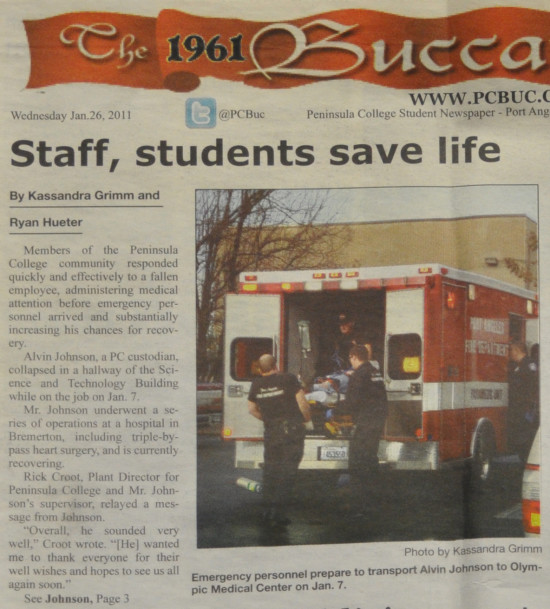
By Mike Drake
On January 7 2011, Peninsula College staff member Alvin Johnson had a massive heart attack and collapsed on the floor in Keegan Hall.
A passing student saw Johnson on the ground and yelled to another student to go get help.
911 was called and CPR was performed on Johnson until the security guard Nate Thompson, arrived with an Automated External Defibrillator.
After a shock was released from the AED, Johnson regained his pulse. EMS arrived put Johnson on a stretcher and loaded him into the ambulance.
The paramedics would shock Johnson two more times with the AED on the way to Olympic Medical Center. Johnson would spend the next three days in a coma.
The first thing Johnson said he remembered after the heart attack was waking up briefly in the ambulance, while being transported to Bremerton for surgery.
Johnson said, “I only remember flashes here and there, other then that it was just like sleeping.” The doctor said the odds of his survival was very small and told family members to start planning for a funeral.
Johnson didn’t give up though.
Miraculously, he would make a full recovery and is still proud to say that he is a staff member at Peninsula College.
Thanks to the quick reaction of two students and two staff members, proper tools and training, a man’s life was saved.
At the time of Johnson’s heart attack there was only one AED machine on campus.
Today there is one located in every building, except for the Library Media Center.
Heart conditions account for roughly one quarter of total deaths in the United State. 785,000 Americans suffer their first, if not their last, coronary attack every year.
Response time is critical to survival in heart attacks victims. If treatment is not administered within 4 minutes, the chance of survival diminishes greatly. 6 minutes after cardiac arrest, the brain dies.
4# Peninsula College student steers local Oso landslide relief effort
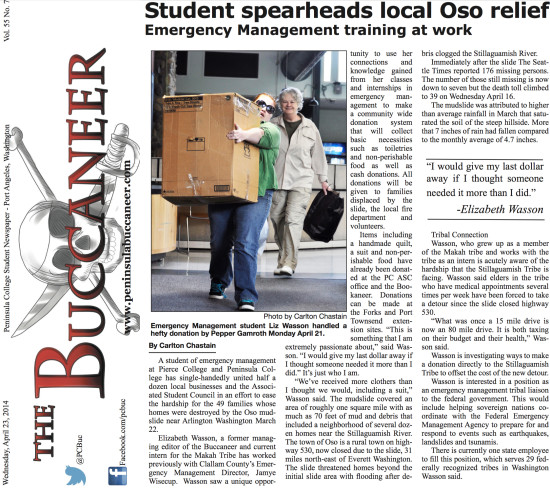
By Chris Urquia
The Buccaneer has seen some very influential issues printed. Some newspapers simply fill space; however, the Buccaneer prides itself on writing the best for the best.
One of such stories, “Student spearheads local Oso relief,” goes in depth on Elizabeth Wasson’s contribution to delivering aid to the community of Oso, Washington.
This specific article was not only excellent due to it being well written, but it was about a member of our community and college.
You might remember from a while back, or you might remember it like it was from yesterday. For Former managing editor of The Buccaneer, Elizabeth Wasson, it’s a memory still fresh in her mind.
March 22, 2014 will be a day she won’t forget, and it certainly won’t be a day forgotten by the people of Oso where 49 families lost their homes, and 43 people lost their lives.
The front page of April 2014’s issue features Elizabeth Wasson carrying a large box of donated goods for the victims of the mudslide.
In 2014, Wasson said, “This is something that I’m extremely passionate about,” and “I would give my last dollar away if I thought that someone needed it more than I did.”
In an interview this month, her mindset still hasn’t changed, and she’s equally as passionate about rallying together and reaching out to people.
“Looking back on the tragedy,” Wasson said, “The ordeal in Oso was terribly sad. I was attached to media and keeping up on hourly updates,” and “one of the nicest things to know is that our own community in Port Angeles and at Peninsula College reached out.”
When asked “what makes a good story at The Buccaneer?” Rich Riski, journalism professor at Peninsula College said, “A good story is a story that makes people talk while being the best obtainable version of the truth.”
Looking back on the front page story featuring Elizabeth Wasson, it doesn’t get much truer than that.
It’s a story of mass devastation, of helping the helpless, and we at The Buccaneer wanted to reminisce and remember why this is a good story and how one of our own stepped out to make a difference.
3# Hometown boys capture first title in school history
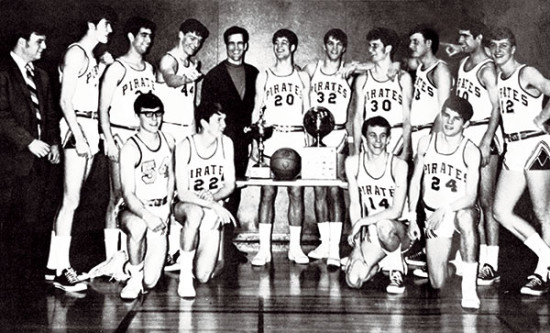
By Eric Trent
Having a hometown roster in college basketball has always been rare. Even more so in 1970, when Peninsula College men’s basketball captured Peninsula’s first championship in school history.
Comprised mainly of local boys, the Pirates employed a ferocious, fast-paced offense to ward off the Lower Columbia Red Devils 132-130, in the title game.
The team’s foundation was built on 5 Port Angeles natives: Bernie Fryer, tournament MVP who later became an NBA referee; Larry Baker; Brad Maier; and twins Art and Dan Ruud.
In 2010, honoring the 40th anniversary of that 1970 title win, Buccaneer sportswriter Ryan Hueter gave readers an inside look into that landmark championship that paved the way for Peninsula’s continued success in the 2000’s.
“The goal of the story was to highlight the historic accomplishments of that team. 2010 being the 40th anniversary of that season was the news peg for the story,” Hueter said.
Hueter was even able to gain an interview with Fryer, who after retiring as an NBA referee, became Vice President and Director of Officials for the NBA.
Fryer averaged an absurd, 31 points per game that season for the Pirates.
“I placed a call to the NBA’s league offices in New York. It took a couple phone calls to get a direct number to the league’s officiating office, Hueter said, “then, it took a couple calls to get a few minutes on the phone with Fryer. When I did get him on the phone, Fryer was very gracious with his team and was happy to recall his memories of that team and their historic season.
“After going through that process, to be able to have a few minutes on the phone with an NBA vice president was very exciting for a young journalist.”
The grueling research needed to write this story, further highlights the importance. Tracking down news information from 1970 would prove laborious for anyone.
“It was difficult to track down any archives to provide me with details from the 1970 season or even the championship game itself,” Hueter said.
“I went to the Port Angeles Library to look at microfiche of the Port Angeles Evening News, and that provided some insight into the season and the team, but not nearly as much information as one might find, for instance, on the 2015 Denver Broncos in 2055.”
#2 Chastain embarks on 14-hour Olympic Peninsula Odyssey
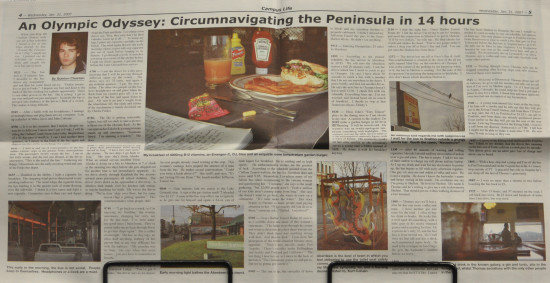
By Britainy Gurr
“Why do you go away? So that you can come back. So that you can see the place you came from with new eyes and extra colors. And the people there see you differently, too. Coming back to where you started is not the same as never leaving.” – Terry Pratchett, A Hat Full of Sky
In Jan. 2007, Quinton Chastain, a reporter for The Buccaneer at the time, took a trip around the Peninsula entirely by bus in the span of 14 hours, costing a mere six dollars and twenty-five cents. He documented his adventure in random intervals, as things occurred, starting very early in the morning.
Chastain’s journey was full of obstacles and definitely didn’t fall short in the eyebrow-raising encounters department. He tells tales of stormy weather at the start, and failed attempts at lighting or holding onto his cigarette as he waits.
He retells stories of a fellow traveler who couldn’t seem to get her life story straight, and seemed rather on the more delusional side. His descriptions are vivid and to the point. Near the end of his trip he encountered a man at a grill and bar who offers to give him a ride to his next stop. During which ride, Quinton made a stronger bond with this stranger, who also had some intriguing stories that he was more than happy to share.
When contacted for comment, Quinton, who still prefers public transportation and bicycles, and has never been licensed to drive any vehicle, summed up his feelings about this experience saying, “‘The Swedish have a phrase ‘smultronstället’. Literally translated it means “the place of wild strawberries”. More colloquially it refers to a special place, somewhere personal, and secretly found, a place treasured and returned to for solace and relaxation; “a personal idyll free from stress or sadness.” Since middle school, public transit buses have been my wild strawberry patch.”
According to the website for the Clallam Transit System, which was established in 1979, if one wanted to take a similar trip, eight years later, it would require transfers between the CTS and Dungeness Line, and take approximately 17 hours.
Chastain refers to this project as his “magnum opus”, and it’s easy to see why. He squeezed every last drop of a story out of his experiences, leaving no stone unturned, and no opportunity unexplored. His descriptive imagery causes the reader to feel as though they are on this adventure with him, which is why the staff here at The Buccaneer voted it the second best archived story to revisit.
1# Buccaneer reporter sheds light on student privacy issues
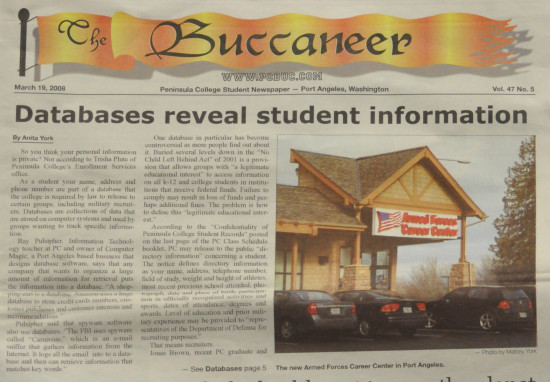
By Hadassah Winters
“So you think your personal information is private?” begins a 2008 Buccaneer article by Anita York, “Not according to Trisha Plute of Peninsula College’s Enrollment Services office.”
This award-winning article published in the March 19, 2008 issue of the Peninsula College Student Newspaper, dives into the complex issue of student privacy.
York interviewed Ray Pulsipher, an Information Technology professor, and Jonas Brown, a PC graduate, enlisted in the Marines, along with mothers of students whose information was accessed by third parties.
According to the article, third parties—mostly recruiters—can legally access directory information such as name, address, telephone number, field of study, as well as the weight and height of athletes, although Plute was quoted in the article saying PC is “only obligated to supply names and phone numbers.”
Now, eight years later, John Feist of the Port Angeles Armed Forces Career center says “I don’t even have a list for PC. All schools are supposed to have an opt-out and I can’t speak for other recruiters, but I don’t have anyone’s height or weight– not even athletes.” Though York’s article describes parents angered about frequent contact from recruiters, Feist says, “If someone is not interested, they’re not interested. I don’t want to leave a negative impact on anyone.”
Jonas Brown, now a security officer on campus, said “I was only contacted once by different branches. If you say no, they know that no means no. They’re not trying to bother anyone. I was contacted by the Marines and that was great because I was actually really interested in joining.”
Krista Francis of PC Enrollment Services said, “It’s all under the Solomon Amendment, which is under federal law. “It gives military recruiters the same information and access to student’s age 17 or older that other recruiters have. But any student can go to Student Services and re- quest an opt-out form, so their information won’t be released.”
The opt-out form is only one page, and if students wish to opt out, the form states that “employers, credit card companies, loan agencies, scholarship committees and the like will be denied any of the student’s directory information.”
“Computer-savvy people may have accepted the use of databases in their daily lives,” York writes in closing, “Even when you use your pager, your voice mail, or your cell-phone, you are likely interacting with what are called ‘object databases’ that work in the background of our digital lives.”
The Excellence in Journal Competition award is framed and hanging on the wall in the Peninsula College Student Newspaper office to this day.
